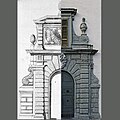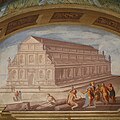Palazzo Salis
| Data | |
|---|---|
| place | Piazza Salis 3, Tirano , Italy |
| opening | 2007 |
| operator |
non-profit organization / ONLUS ITA-SUISSE
|
| Website | |
The Palazzo Salis is located in the center of the historic old town of Tirano , a town in the Valtellina , part of the Lombardy region (Province of Sondrio), and was built by the Salis-Zizers branch of the important von Salis family from Graubünden during the second half of the 17th century built. The building is one of the largest and most important palazzi in the entire Valtellina and is now run as the Museo PalazzoSalis.Tirano .
Family von Salis and Salis-Zizers
The family name of the Salis is derived from the Latin name for the willow tree (Latin salix). This is also reflected in the heraldic representation of the family coat of arms. In the heraldic shield, a green, uprooted willow tree is depicted on a golden background.
The origin of the Salis family can be found in the Lake Como region (Sala Comacina and Campo). Presumably due to the aftermath of the clashes between the expanding Milan and the city of Como in the 12th century, many noble families moved north of Lake Como, including the Salis family. This consequently settled between Chiavenna and the Bergell in the strategically favorably located village of Soglio. The first documented representative of the Salis family in Soglio was Rudolf Salis, who died in 1300. Starting from Soglio, they were able to steadily expand their influence over the entire Bergell . As part of the formation of the church association , the Salis expanded their economic and political influence here as well. After merging to form the Free State of the Three Leagues , they finally branched out in the 15th and especially in the 16th century, increasingly within the boundaries of the Ten-Court League and the Gray League. The path of the family branch in Tirano led from Soglio to Malans around 1550, to Zizers in 1614, and finally to Tirano after 1637. During the Graubünden rule in the Valtellina, members of the Salis family provided a very large number of officials in the Graubünden valley administration, especially in the 17th and 18th centuries.
Building history and equipment
The Palazzo Salis is located in the historic district of Capo di Terra, in the north-eastern part of the old town of Tirano, which was surrounded by a fortification wall at the end of the 15th century. The initiative to build the palazzo came from Johann Salis-Zizers, who resided in 1661 and 1665 as city bailiff in Tirano, and from 1679–1681 even served as valley governor of the Bündner Herrschaft in Valtellina. Around the middle of the 17th century, four already existing smaller aristocratic residences from the 16th century were combined into one large building. The facade of the palazzo shows an imposing severity and regularity and thus stands in contrast to the frescoed rooms of the palazzo. The portal of the main entrance gate was designed according to a design by the architect Giacomo Barozzi (il "Vignola") from the 16th century and made from the local greenish Grosotto stone typical of the region. The building is basically divided around two central courtyards, the so-called corte della meridiana (courtyard with sundial) and the corte dei cavalli (horse farm).
All ten halls, which are arranged around the corte dei cavalli , were painted with partly impressive frescoes, most of which date from the time the palazzo was built, and thus to the second half of the 17th century. An exception is the large ballroom ( salone d'onore ) of the Palazzo, which was repainted after being damaged by fire in the 18th century and is a work by Giovanni Antonio Cucchi and Ferdinando Crivelli .
In the small salon ( Saloncello ) there is a stucco fireplace that dominates the room and was built on the occasion of the wedding of Giovanni Stephano Salis to Katharina von Wolkenstein. The numerous coats of arms above the doors of the Saloncello (including Medici , Borromeo , Visconti ) express the importance and political connections of the family. Finally, in the center of the ceiling is Bacchus , the god of wine, and thus points to the economic position of wine for the Salis family in Tirano. The design of the ceiling of the Saloncello is an example of the illusion of space by means of painted architecture ( trompe-l'œil ), which simulates three-dimensionality to the viewer.
The foundations of the palazzo also contain the historic wine cellars, which were probably built in the 15th or 16th century together with the previous buildings of the Palazzo Salis and were combined by the Salis to form a large cellar. The Italian garden of the Palazzo Salis is a rarity in the Alpine region of northern Italy. The current state of the facility is the result of various construction phases between the 17th century and the second half of the 19th century. The garden of Palazzo Salis is dominated by a labyrinth of evergreen box hedge that surrounds a centrally located fountain. The large Lebanon cedar, which, along with the hedge labyrinth, characterizes today's image of the garden in Palazzo Salis, dates from around the 1830s when some adaptations were made to the garden.
The Palazzo has been owned by the Salis-Zizers family since it was built and parts of it have been open to the public since 2007. The PalazzoSalis.Tirano Museum is the part of the Palazzo that is decorated with frescoes from the 17th / 18th centuries . Century, as well as the historical gardens at the back of the building.
gallery
literature
- Archivio Salis - Palazzo Salis Tirano .
- Palazzo Salis - Guide to the Museo PalazzoSalis . Tirano, Sondrio 2015 (Italian, English, German).
- A. Corbellini, F. Hitz: The Bündner in the Veltlin, in Bormio and in Chiavenna . Sondrio-Poschiavo 2012.
- G. Garbellini: Tirano - Il centro storico . Sondrio 2009.
- P. Daverio: L'invencible armada al crocevia di Tirano . In: Corriere della Sera , April 13, 2013.
- S. Gavazzi: Residenze nobiliari di Valtellina e Valchiavenna . Sondrio 2002.
- G. Jäger u. a. (Ed.): The end of the Bündner Herrschaft in Valtellina and in the counties of Chiavenna and Bormio in 1797 . Sondrio 2001.
- N. Salis-Soglio: The family of Salis . Lindau 1891.
- R. Sertoli Salis: I Salis di Valtellina . Sondrio 1953.
- R. Sertoli Salis: Palazzo Salis di Tirano . Milano 1973.
Web links
Coordinates: 46 ° 13 '0.7 " N , 10 ° 10' 29.5" E












